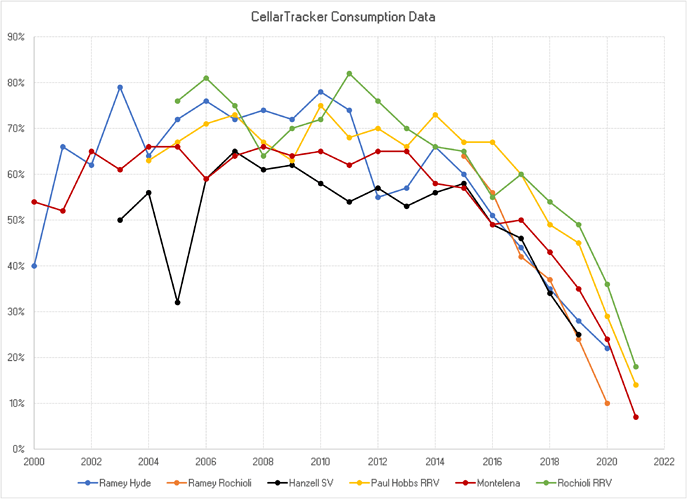Hello everyone! I’m diving into the world of wine and thrilled to be a part of this forum! The wealth of knowledge here is incredible, and I’ve been soaking it all in.
One aspect of wine that’s been puzzling me is determining the ideal drinking window. I understand it’s quite subjective, but I’ve been wondering if there’s a more data-driven approach we can explore. Instead of relying solely on expert opinions or community-sourced CT drinking windows, could one turn to the consumption data in the Community Holdings section?
Could this collective data, showing how much of a particular vintage has been consumed, provide insights into when a wine might be at its best? For instance, if only 7% of a wine with a substantial sample size from a specific vintage has been consumed, it might be too early to pop the cork. On the other hand, if 40-60% of the vintage has been enjoyed, could this suggest that the wine is hitting its peak?
I’m aware this is far from an exact science, and the “perfect” moment to open a bottle is elusive. But maybe, by looking at a range or trend in consumption, we can tap into the collective wisdom of experienced wine drinkers who track their cellars on CT.
So, what are your thoughts on this approach? Does it even make sense? If it does, what percentage consumed do you think might indicate a wine is at its best? I’ve created a chart illustrating the consumption data for six California Chardonnays, and it’s intriguing to see how similar their consumption curves are. I’m curious to hear your opinions, especially considering how this approach might translate to red wines, an area I’m looking to explore more.
2 Likes
Very interesting. One would have to exclude bottles deemed OTH. Also bottles are opened for exploratory purposes. Without analysing notes I suspect results would not be as good as the community estimates.
With such an analysis by an AI algorithm the results would be interesting. But would they differ from community estimates?
1 Like
i think this core thesis might be inherently flawed. It’s overwhelmingly not subjective through the lens of “what do the most knowledgeable and experienced drinkers expect from this wine at peak and when?”
For example, if you’re serious about Burgundy, then you’ll either know or defer to the most knowledgeable people that have experience with Burgundy and you’ll not drink most of your wines at age 4. Though some may choose to, that’s not the goal of this exercise, and isn’t useful data.
I think where CT can provide real value here is notes-based sentiment analysis on an individual wine and then perhaps expand that more generally to a region, vintage, producer, etc., to eventually say something like “volnay from ripe vintages peaks around 13 years from the vintage.” That’s a very actionable statement.
Consumption data from CT, from this POV, is a lagging indicator which isn’t what you’re after. To say nothing of the very reasonable argument that public consumption data will actually drive more consumption by other CT users.
The consumption curve for every wine will have the same shape because reasons, but the slopes will differ; to what extent is the goal here.
edit: PS you likely want to check out this thread: CellarTracker Suggestion Thread
1 Like
Interesting idea about using consumption data to help determine drinking windows! I do think @RichardFlack and @ybarselah brought up some good points about potential limitations. Consumption alone may not tell the whole story, as there are many reasons people open bottles beyond just being at peak. Looking at actual tasting notes from experienced users over time could provide more useful insights. Still, analyzing overall trends could yield some general guidance. Nice thinking outside the box - exploring additional data sources.
1 Like
Great idea!
I have used CT consumption data as a single data point for best drinking window for years and find it very helpful. I agree with your rationale and you are much more sophisticated than me.
I simply look at % consumed and find that, for large CT holdings, between 33% and 66% (+/- on both) correlates pretty well for me!
Obviously, there are other factors, the most important being tasting notes. Also, small sample size, older vintage that is pre-CT, my personal preference for tertiary development on some bottles, etc.
However, when someone says “drink up” and I have not pulled the cork on one, seeng 17% consumption readily puts my mind at ease. Also, it helps me to be patient when holding a single or small stash and see others are holding, too. Finally, for the upper end of the window, I find the 66% consumed correlates better with my taste than does the typical CT crowd sourced “drink by”.
Keep at it, I think you are on to something.
1 Like
A very interesting idea! I agree that consumption date is not a great measure for optimal drinking window. That said, I would love a CT feature add for when a bottle is consumed. Right now, there is an option to add a drinking window. What about adding options to select “drank too soon” “past peak” and so forth. This would yield some very useful info beyond a drinking window guesstimate.
2 Likes
A goodly number of posters love infantcide. Kills the reliability of consumption data. Too many times to count have I seen notes from wine club winemakers saying the wine should be laid down for at least a year, and people posting notes on how it needs time!  .
.
1 Like
Feels like test scores in school, you could throw out the very low end as you’ve mentioned. Still not ideal, but could tighten up the range a bit more.
